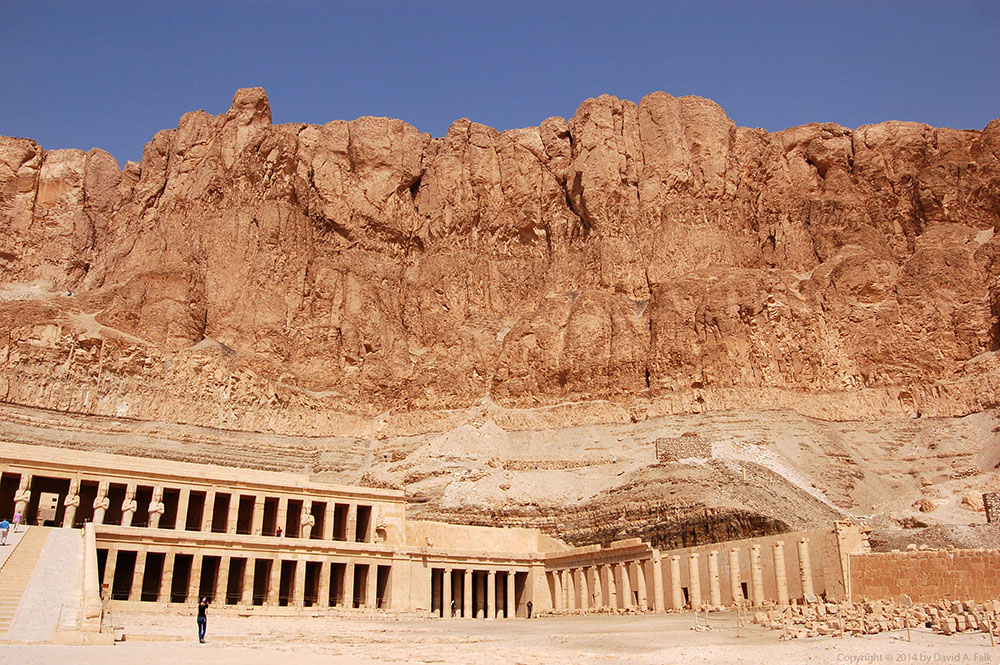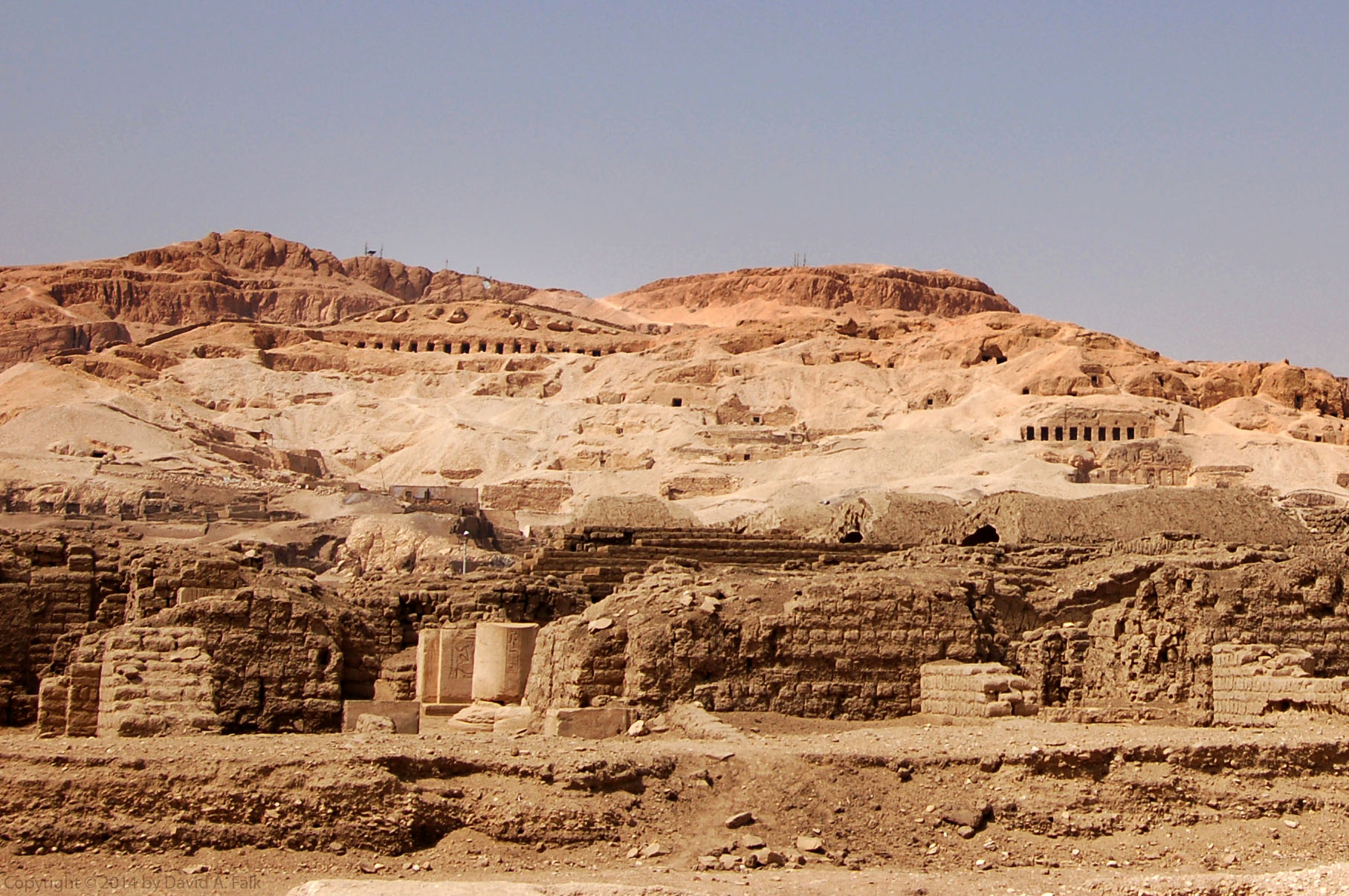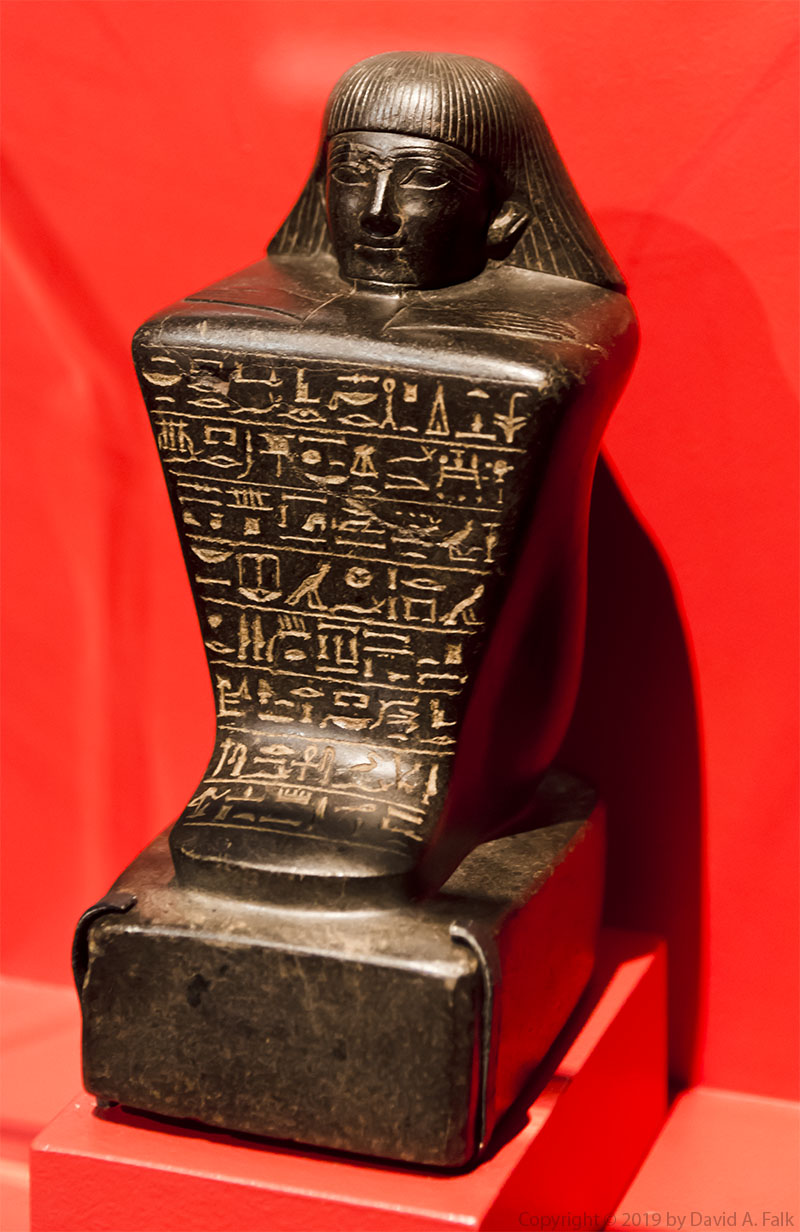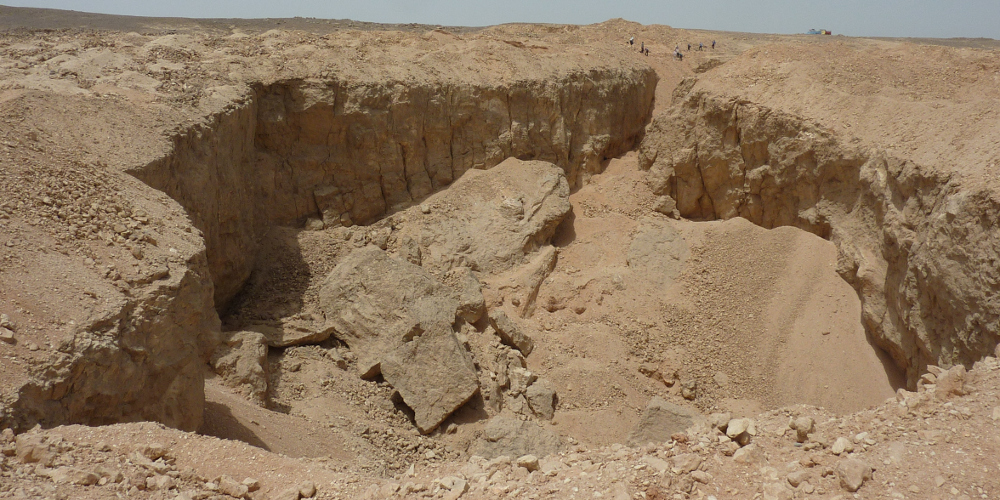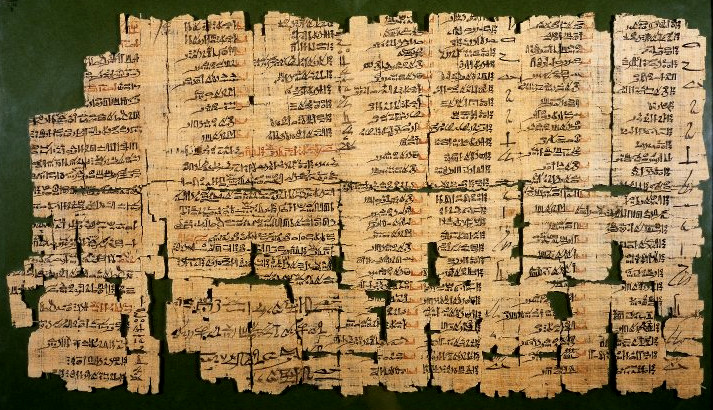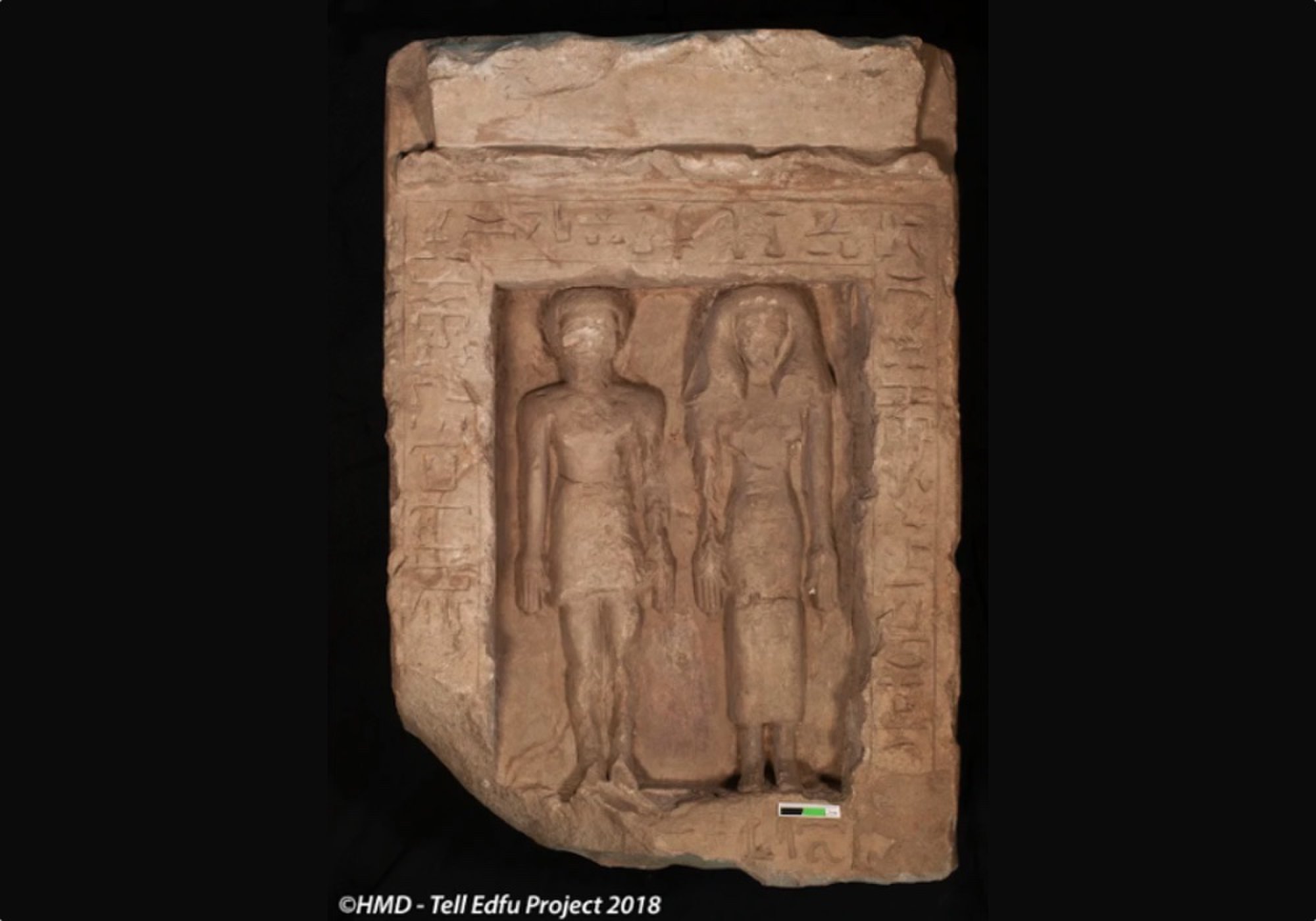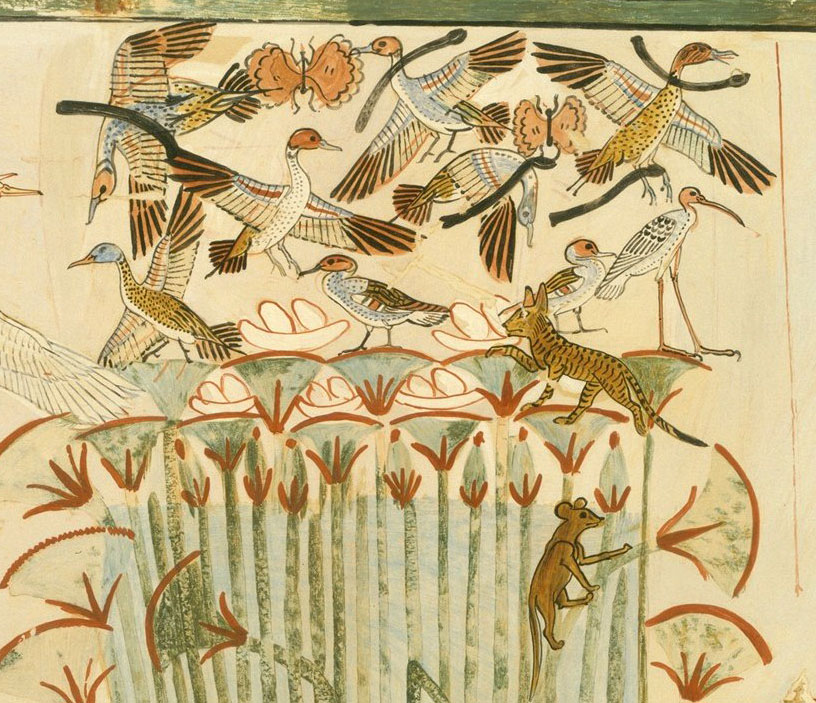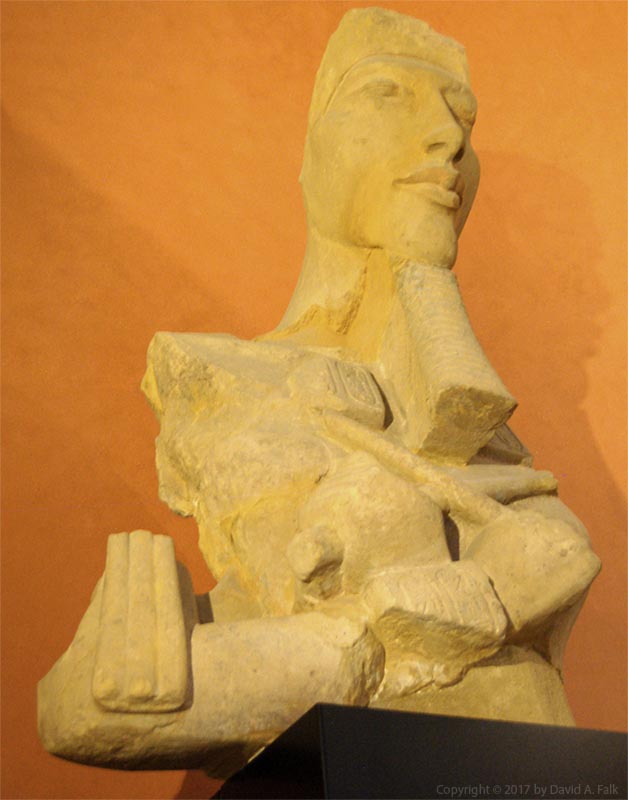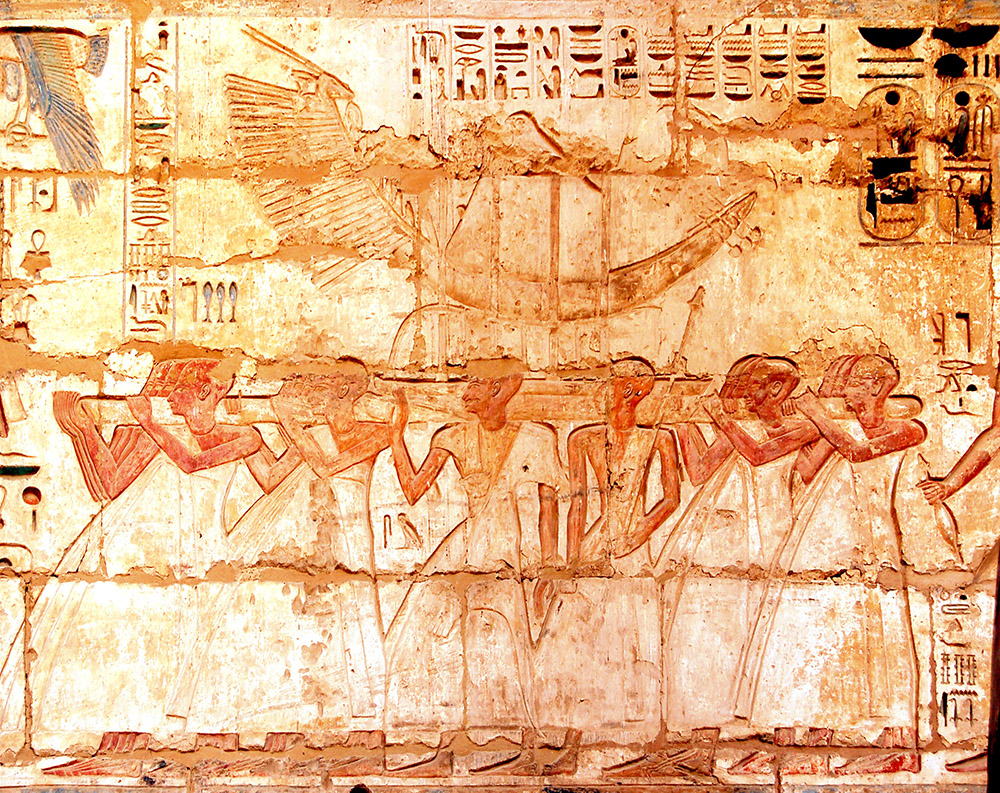A panorama photograph of the Peristyle Hall at Medinet Habu. Medinet Habu was initially built as the mortuary temple for Ramesses III, but later on became the main administrative center for West Thebes during the 20th and 21st dynasties. Unlike many of the mortuary temples in West Thebes, Medinet Habu is largely intact and even much of the paint on the reliefs remains preserved. Ramesses III reigned for 31 years and was assassinated in a conspiracy by his royal harem (Queen Tiye) to put a minor son, Pentawere, on the throne over the crown prince Ramesses IV.
Category: Egyptology
Deir el-Bahari against the cliffs
This is a photo of Deir el-Bahari against the cliffs. This was the mortuary temple of Queen Hatshepsut of Dynasty 18. The temple is located in West Thebes next door to the Middle Kingdom temple of Montuhotep. When one visits Deir el-Bahari, one immediately notices the cliffs looming overhead. I wanted to capture the magnitude of the cliffs compared to the temple.
Saf Tombs from West Thebes
Over the next few months, I’m going to be actively engaged in writing my new book on the Ark of the Covenant and ancient Egypt. As such, I’m going to devote most of my time and energy to that endeavor. Unfortunately, I’m not going to be publishing blogs at the pace that I was.
However, what I am going to do is publish some photographs that I have taken over the years with a brief commentary. These photos should be of interest since they are taken with the eye of an archaeologist. So they should give you an unique perspective on Egypt.
Today’s photograph was taken at West Thebes. It is a photograph of a pair of saf tombs as seen from the Ramesseum. saf tombs typically date from the 11th to early 12th dynasties.
The American Research Center in Egypt (ARCE) annual meeting
Crime and Punishment in Ancient Egypt
Egyptian society generally had no laws. Instead, the Egyptians governed their society by an ethical concept called Maat, “order.” This concept led to a pretty permissive society. If an act did not disrupt the community and was not an act against the king, it was generally permitted.
Punishment for Crimes
We have to remember that Egyptian ruled by a brutal military dictatorship. So magistrates maintained order by force and corporal punishment. Acts against the king were usually met with the death penalty. But for lesser offenses beatings were commonplace.
However, magistrates did not only use beatings to punish crime but also as an interrogation method. The way the Egyptians used beatings was that they would beat you first before asking any questions, ask their questions, then beat you again if they felt like you needed it. Interrogators only believed that they got honest answers when an interrogation first started with a beating.
Egyptian Jails
If the magistrate or king could not decide what to do with you, they would send you to jail. In Genesis 39, we read about Potipher’s wife falsely accusing Joseph of rape. As a slave, this crime would earn more than a beating. But if the accuser was less than reputable, it would not necessarily warrant the death penalty. Perhaps, Potipher understood the character of his wife. So Joseph was sent to Egyptian jail [Gen 39:20].
Now, the Egyptian concept of jail might not be what you expect. The Egyptians used their rock quarries as jails. Quarries existed that were the operated by skilled professional stone cutters [see featured image]. However, quarries were also used as prisons.
Egyptian jails had no doors, bars, or walls. Succinctly put, these jails needed no restraints. Quarries typically were found in remote locations with very little water. If anyone tried to escape, they would be subject to the heat of the desert and die of dehydration in short order. This was strong incentive to stay and do one’s time.
Dreams and their Interpretation
The Egyptians believed that dreams could foretell the future. And as such the interpretation of dreams played an important part of ancient Egyptian culture. In fact, the interpretation of dream persists among modern Egyptians today.
The Dream Book
Two so-called “dream books” have survived from ancient Egypt. Perhaps the most interesting is Papyrus Chester Beatty III, a fragmentary papyrus written in hieratic. This papyrus is a catalog of dreams and their interpretations.
The format of the interpretations is quite formulaic. All the dreams are predicated upon you appearing your dream. The dream is then summarized. The book then gives a one-word appraisal of the dream, either “good” or “bad.” And then the book predicts what’s going to happen to you.
A couple of examples from the dream book are as follows: “[if a man sees himself in a dream] seeing the god who is above–good; it means much food.” Or, “[…] seeing himself [in] mourning–good; the increase of his possessions.” Or, “[…] looking in a deep well–bad; his being put into prison.” Or, “[…] seeing an ostrich–bad; harm befalling him.”
The content of these dreams were not limited by propriety or societal mores. Dream books provided interpretations for dreams involving drinking wine, engorged genitals, and copulating with one’s mother. Also, some of these dreams could be quite cringe worthy, such as, drinking one’s own urine or blood, or copulating with a pig. Counter-intuitively, the dream books considered some of these noxious dreams to have good outcomes.
Joseph and Dream Interpretation
One cannot refer to dream books without being reminded of the dream interpretations found in the Bible, most notably those interpretations done by Joseph. Joseph was sent to prison where he interpreted the dreams of his fellow prisoners. Joseph interpreted the dream of a cupbearer:
So the chief cupbearer told his dream to Joseph, and said to him, “In my dream, behold, there was a vine in front of me; and on the vine were three branches. And as it was budding, its blossoms came out, and its clusters produced ripe grapes. Now Pharaoh’s cup was in my hand; so I took the grapes and squeezed them into Pharaoh’s cup, and I put the cup into Pharaoh’s hand.” Then Joseph said to him, “This is the interpretation of it: the three branches are three days; within three more days Pharaoh will lift up your head and restore you to your office; and you will put Pharaoh’s cup into his hand according to your former custom when you were his cupbearer. [Gen 40:9-13]
The Chester Beatty papyrus has a similar dream. “[…] seeing himself with one greater than he–good; it means his promotion by his (own) agency.” The cupbearer saw himself serving the king, so a promotion or restoration of position was the expected interpretation.
Pharaoh’s Dream and the Dream Book
The cupbearer remembered Joseph as an interpreter of dreams and suggested to the king that Joseph could interpret his dream. Joseph interpreted the king’s dream as foretelling seven years of plenty followed by seven years of famine. The king described his dream as follows:
Now it happened at the end of two full years that Pharaoh had a dream, and behold, he was standing by the Nile. And lo, from the Nile there came up seven cows, sleek and fat; and they grazed in the marsh grass. Then behold, seven other cows came up after them from the Nile, ugly and gaunt, and they stood by the other cows on the bank of the Nile. The ugly and gaunt cows ate up the seven sleek and fat cows. Then Pharaoh awoke. He fell asleep and dreamed a second time; and behold, seven ears of grain came up on a single stalk, plump and good. Then behold, seven ears, thin and scorched by the east wind, sprouted up after them. The thin ears swallowed up the seven plump and full ears. Then Pharaoh awoke, and behold, it was a dream. [Gen 41:1-8]
The Chester Beatty papyrus has some favorable interpretations that reference bovines. “[…] seeing a dead ox–good; it means seeing [the demise?] of his enemies.” “[…] killing an ox–good; killing his enemies.” “[…] carving up an ox with his (own) hand–good; killing his (own) adversary.” And, “[…] bringing in the cattle–good; the assembling of people for him by his god.”
But there are also some unfavorable interpretations. “[…] feeding cattle–bad; it means roaming the earth.”
Grain is also referenced. “[…] seeing barley and spelt [given?] to those yonder–good; it means the protection of him by his god.” “[…] measuring barley–bad; it means the arising of words with him.”
Likewise, dreams provided predictions for harvests. “[…] seeing a large cat–good; it means a large harvest will come to him.”
What can we make of Dream Interpretations?
Although the Chester Beatty papyrus is far from complete, we can see that the interpretation of dreams was codified knowledge. A lot of questions remain regarding how the ancient Egyptians interpreted dreams. How did the Egyptians interpret more complex dreams? How extensive were these dream books? Did the Egyptians standardize dream books? How many editions were in circulation? Fortunately, the Chester Beatty papyrus gives us a tantalizing start to this fascinating subject.
Death of Memory
The latest from the excavation at Tell Edfu reported the discovery of a private shrine inside a home. Such a find is normally rare as few private shrines have survived the archaeological record. But more interesting is that someone scratched out the faces of the worshiped figures. Modern scholars call this the damnatio memoriae, “the damnation of memory.”
The ancient Egyptians said that a person dies three times: death of the body, death of the memory, and death of the name. First, one’s physical body dies. Second, the memory of the person dies as those carrying a living memory of that person also die. Finally, the person suffers a death of name as all traces of his name, when all traces of the name (or image) of that person perish.
An interesting block from Tell el-Amarna shows a relief of two Nubians and two Semitic Asiatics. The faces of the Asiatics were chiseled out while the faces of the Nubians remained intact. Workers took the block from one Akhenaten’s construction projects and used it as fill for a pylon during the reign of Seti I. This means that the defacement took place between the reigns of Tutankhamun and Seti I. The damnatio memoriae was an attempt to destroy the memory of the Asiatics to hasten their ultimate death.
Ancient Egyptian Cats
The role of ancient Egyptian cats is quite fascinating. Claudio Ottoni wrote an interesting article this week on the domestication of one of humanity’s favorite companions. Ottoni suggests that the relationship between cats and humans began as a commensal relationship established during the early development of agriculture.
During the neolithic period, humans were domesticating grains in Turkey. As humans gathered these early grains, the harvests attracted rodents looking for an easy meal. The African wildcat (Felix silvesterus lybica) started to encroach upon human settlements. And humans discovered that their new partners had added benefits beyond vermin control.
Despite the commensal relationship cats had formed with humans everywhere, the Egyptians would complete the domestication of the modern house cat (Felix silvesterus catus). While the African wildcat was still hanging out on the fringes of early European settlements, the Egyptians had already invited cats into their homes as pets.
However, one specific aspect to Egyptian cats that may seem strange to us is that the Egyptians trained their felines. You only thought cats trained their humans, didn’t you? The Egyptians trained these felines to hunt. For sport, the Egyptians used trained cats to flush out game while the hunters hurled throwing sticks (see painting above). Early cats were the Egyptian equivalent to the golden retriever.
Atenism, was it really monotheistic?
Aten living daily content in the sky, Your offspring, your august son, Sole one of Re; The Son of Re does not cease to extol his beauty, Neferkheprure, Sole-one-of-Re. I am your son who serves you, who exalts your name. Lichtheim, Literature, 2:91-92.The theological implication of this is important. James Hoffmeier summarizes this situation as “the anointing of the king to make him the Son of God.” Kingship in Atenism is the manifestation of the incarnate Aten. The reference to a unique son speaks to a common theme in ancient Near Eastern literature, which is the idea of an offspring that will carry the legacy of the parent. This motif appears in the inheritance laws of ancient Mesopotamia. It also is found in early Israelite thought with the promise of a son to Abraham even though he already had a son in Ishmael. In ancient Egypt, inheritance often was associated with the passing on of a title or occupation as well as property. Atenism differed from classical Egyptian thought in the belief of creation. Traditional Egyptian belief focused upon creation myth as foundational. But Atenism disregarded physical creation altogether while maintaining the Aten as creator. Akhenaten extolled the Aten as the “creator of all, who makes them live, Great Falcon, bright of plume; a beetle who raised himself, he who was self-created, he who was never born.” Atenism accepted the idea of immanence in the act of continuous creation. The substance and breath of the Aten made every living being alive. “You are One, yet a million lives are in you, To make them live <you give> the breath of life to their noses.” Aten was bidirectionally eternal. That is the Aten was in eternity past the same as he is today and going forward will remain the same. Thus, the answer to the question of origins always centered upon manifestations of the Aten. This sort of divinity was not quite henotheism in the classical sense nor was it any kind of monotheism per se. Because Atenism popularized “the One and the Many” theology, Akhenaten’s religious reforms transformed Egyptian religion from a plurality of gods to one deity radiating from a single source incorporating the substance of all other gods. Atenism was the ultimate deconstruction of deity that Amenhotep III had first attempted, carving out of Egyptian religion a monolatrous pantheism. The preceding preview was an edited extract taken from a book chapter recently submitted to Oxford University Press.
The Phenomenology of Egyptian Carved Reliefs
The Egyptians believed that writing and drawings instantiated magical power and presence. And that is because Egyptian metaphysics tied magic to writing, both of which were attributed to the god Thoth.
Let us say that I were to write a mild curse on a piece of paper “may there be one less step than my nemesis expects.” The Western mind would think nothing of this other than to maybe crack a wry smirk because in the West something written on a piece of paper has no more power than a bitter tweet or a nasty greeting card. Separation exists between the agency of the writer, the object of writing, and the mechanics of the world.
With the ancient Egyptian mind, that separation does not exist. Divinity had the ability to unite with its images (both statuary and temple reliefs) embodying the god’s divine power. This resulted in a phenomenological view of writing. Writing a mild curse on paper created an object of writing that affected the mechanics of the world. The contents of the written form change the fabric of reality. So, my mild curse would cause my nemesis to trip at every set of steps he climbs.
In the same manner, the reliefs that the Egyptians carved on their temple walls created perpetual reenactments of a ritual in writing for the benefit of their gods. The carved reliefs recreated rituals to praise the gods day and night.
The preceding blog was an abridged excerpt out of the book that I am currently writing.

